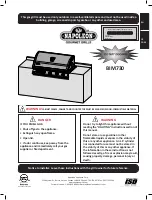
C H A R B R O I L.E U
Page 5
GAS SAFETY AND CYLINDER CARE
Fuel Gas
• Is nontoxic, odorless and colorless when produced. For Your Safety ,
fuel gas has been given an odor (similar to rotten cabbage) so that it
can be smelled.
• Fuel gas is highly flammable and may ignite unexpectedly when mixed
with air.
Gas Cylinders
.
• The cylinder must be installed, transported and stored in an upright
position and should not be dropped or handled roughly.
• When the barbecue is to be stored indoors, the gas cylinder must be
disconnected from the barbecue.
• When the gas cylinder is not disconnected from the barbecue, the
barbecue and cylinder must be stored outdoors in a well-ventilated
space.
• The cylinder should never be transported or stored where tempera-
ture can reach 51 °C.
• Cylinders must be stored outdoors out of the reach of children.
• Do not store an gas cylinder in enclosed spaces such as a carport,
garage, porch, covered patio or other building.
Gas Cylinder Installation/Removal
Gas Cylinder Installation:
1. Be sure barbecue control valves are in the
OFF
position.
2. Perform a leak test.
Gas Cylinder Removal:
1. Turn control valves
OFF
.
2. Allow Barbecue to cool.
Additional Safety Considerations
• This barbecue must be kept away from flammable materials during
use.
• When changing the gas cylinder, you must be sure the barbecue is
kept away from any source of ignition.
• Turn off the gas supply at the gas cylinder after use.
• Avoid kinking the hose.
• Change the flexible hose when national regulations stipulate this as a
requirement.
• Any parts sealed by the manufacturer must not be altered by the user.
• Any modification of the barbecue may be dangerous.
• The gas must be turned off at the cylinder when your barbecue is not
in use.
• WARNING:
Make sure that the cylinder valve is closed when the
barbecue is not in use.
• If storing the barbecue indoors, first
DISCONNECT
the gas supply
and store the cylinder outdoors in a well-ventilated space.
• If you do not disconnect the cylinder from the barbecue, be sure to
keep both the barbecue and the cylinder outdoors in a well-ventilated
area.
• Always close the cylinder valve before disconnecting regulator.
• Cylinders must be installed, transported, and stored in an upright posi-
tion.
• IMPORTANT NOTICE:
We recommend that you replace the gas hose
assembly on your barbecue every five years. Some countries may have
requirements that the gas hose be replaced within less than five years,
in which case that country’s requirement would take precedence.
Summary of Contents for 140881
Page 117: ...CHARBROIL EU 117 REPLACEMENT PARTS DIAGRAM...
Page 121: ...CHARBROIL EU 121 ASSEMBLY MONTAGE 3 4 1ST 2ND E x 4 1ST...
Page 126: ...CHARBROIL EU 126 ASSEMBLY MONTAGE 9 10 K x 4 G x 4 H x 6 I x 6 J x 6 I H J...
Page 127: ...CHARBROIL EU 127 ASSEMBLY MONTAGE 11 12 H x 1 J x 3 E x 1 F x 2 x2...
Page 128: ...CHARBROIL EU 128 ASSEMBLY MONTAGE 13...
Page 132: ...CHARBROIL EU 132 ASSEMBLY MONTAGE 17...
Page 135: ...CHARBROIL EU 135 ASSEMBLY MONTAGE 21 22...
Page 146: ...CHARBROIL EU Page 146...
Page 147: ...CHARBROIL EU Page 147...






































